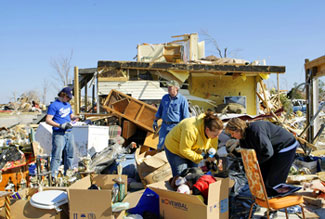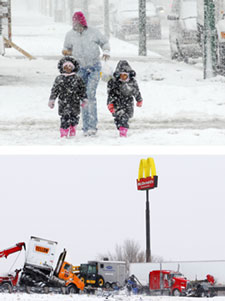FCNNEWSSOURCE
Tornadoes kill 59 in South, snowstorms stun Midwest
Video: Tornado Injures 29; Damages Homes, Businesses (AP Video, 02-18-2008)

(FinalCall.com) – President George W. Bush said the U.S. stood ready to help as he tried to lift the spirits of people in a rural Tennessee county that suffered the heaviest death toll from dozens of tornadoes that tore across five states, killing at least 59 people.
“There’s no doubt in my mind this community will come back better than before,” President Bush said Feb. 8 in Lafayette, Tenn., a poor tobacco-farming area near the Kentucky border. “Macon County people are down-to-earth, hardworking, God-fearing people. They’re just getting a little help and will come back stronger.”
In all, Mr. Bush spent about 2 1/2 hours in the disaster zone. But it was notable that he sped to the region, arriving for a firsthand view less than three days after the tornadoes roared through.
The Bush administration has been criticized for its handling of other disaster situations, most notably the aftermath of Hurricane Katrina in 2005, which ravaged the U.S. Gulf Coast, displacing hundreds of thousands and destroying entire neighborhoods.
Even before Mr. Bush landed, he declared major disasters in Tennessee and Arkansas, a move that opens the spigot of federal funding to cover some costs, shared with local governments, for debris removal and protective measures and to help individuals. Sensitive to criticism it was ignoring other states hit by the storms, the White House said these were the only two states that had so far asked for help.
A barrage of tornadoes swept through Tennessee, Arkansas, Mississippi, Kentucky and Alabama Feb. 5, and the death count was nearly 60. Macon County suffered the heaviest toll, with 14 deaths.
Macon County residents worried about looters, power shortages and a large number of residents still unaccounted for in the aftermath of the stunningly deadly and destructive tornadoes.
Gov. Mike Beebe declared 10 Arkansas counties as disaster areas following the storms. Baxter, Conway, Independence, Izard, Pope, Randolph, Sharp, Stone, Union and Van Buren counties received the designation after a Beebe tour.
After the deadliest wave of tornadoes to hit the South in more than two decades, dazed authorities and residents were wondering what could be done differently next time.
There was new interest in tornado sirens in places like Macon County and consideration of other changes there and elsewhere across tornado-prone areas of the South. Officials cited strong storm awareness and disaster drills with helping Union University, in Jackson, Tenn., avoid loss of life as tornadoes roared through.
The powerful set of storms included a ground-hugging tornado that roared across northern Tennessee with wind estimated at 125 top 150 mph. That twister was blamed for 24 of the deaths.
“A lot of it is just members of the public taking seriously that it can happen,” said Tennessee Gov. Phil Bredesen, who toured stricken areas. “You get a little more convinced each one you see.”

Michael Chertoff, U.S. Homeland Security director, said the preparation and response was evident in Jackson, in western Tennessee, hit repeatedly by tornadoes in the past decade, including one that killed 10 people in the area in 2003.
Forecasters had said conditions were ripe for strong storms, and there were long lead times in tornado warnings. Until television sets blinked off in many homes as power was knocked out by advancing storms, a number of survivors said they had been monitoring the warnings.
Telia Sorrells, 24, was sitting on her couch watching TV weather reports in her home just before electricity went off and the tornado tore apart her house here the night of Feb. 5. She said she didn’t realize the tornado was upon her until she heard a loud noise and then looked up to see nothing but sky and felt blood running from her gashed head.
Western storms bring snow
Blue skies opened up over California on Jan. 28 after a storm system that had pummeled the state for days finally moved on, bringing heavy snow, flooding and hundreds of wrecks to several states across the West.
Colorado’s San Juan Mountains were socked with 30 inches of snow and wind gusts of as high as 100 mph, while roofs collapsed at several businesses in north Idaho after 20 inches of snow fell around Coeur d’Alene.
In Durango, Colo., about 340 miles southwest of Denver, even the sledding hills were at risk of avalanches after 18 inches of snowfall.
In Spokane, Wash., where 13.7 inches of snow fell, city officials closed City Hall and urged residents to stay home to give snowplows a chance to catch up. City and county governments told nonessential workers to stay home.
In eastern Oregon’s Wallowa Mountains, authorities found two snowmobilers missing over the weekend in the 4 feet of snow that fell there. One was safe in a cabin, but the other was “extremely hypothermic” and under the care of a nurse and paramedic who flew in on a helicopter. The snow was too heavy for the helicopter to lift off, 911 dispatch director Jerry Boyd said.
Snowbird ski resort in Utah stopped the chair lifts more than two hours early after receiving about 15 inches of snow.
Avalanches damaged four houses and a garage northwest of Ketchum, Idaho, and the potential for more falling snow sent police door to door to evacuate 71 homes, said police spokeswoman Kim Rogers.
Temperatures plunge in the Midwest
The Midwest had its share of troubles too.
It was so cold Feb. 10 in the Upper Midwest, and visibility was so poor in blowing snow, that church services were called off in parts of Michigan. At noon, thermometers in one North Dakota town still registered only 20 below zero.
The windy, bitterly cold weather blanketed a region from the Dakotas across much of Minnesota into Wisconsin and Michigan. Subzero temperatures at midday extended into northern Iowa, the National Weather Service said.
Snow whipped up by the bitingly cold wind created hazardous driving conditions Feb. 10 in Michigan. State Police said the 5-mile-long Mackinac Bridge was closed because of whiteout conditions, and the sheriff’s office in southwest Michigan’s Cass County said visibility was less than 20 feet.
Churches across western Michigan canceled services, The Grand Rapids Press reported.
Snow drifts also closed some roads in Wisconsin and Michigan, police said.
Sunday’s noon reading at Devils Lake, N.D., was 20 below, with a wind chill of minus 38, the weather service said. On Saturday, the town warmed to a high of 13 below–with a wind chill of minus 42.
International Falls, Minn., the Canadian border city that’s won the trademark of “Icebox of the Nation,” was only 15 degrees below zero by noon Feb. 10, but the wind chill was a painful 40 below.
Federal disaster area declared in Hawaii
The head of the U.S. Department of Homeland Security’s Federal Emergency Management Agency said federal disaster aid had been made available for Hawaii to supplement state and local recovery efforts in the area struck by severe storms, high surf, flooding and mudslides during the period of December 4-7, 2007.
The hardest hit areas were in Hawaii, Kauai, and Maui counties.
Federal disaster aid was also made available for Missouri to supplement state and local recovery efforts in the area struck by severe storms, tornadoes and flooding during the period of January 7-10, 2008. Storms, tornadoes and flooding in Barry, Dallas, Laclede, Maries, McDonald, Newton, Phelps, Stone and Webster counties were eligible for the aid.
FEMA coordinates the federal government’s role in preparing for, preventing, mitigating the effects of, responding to, and recovering from all domestic disasters, whether natural or man-made, including acts of terror.
According to FEMA.gov, FEMA spent over $1.4 billion responding to disasters in 2007. Out of that $241 million reportedly went to assist individuals and households with temporary housing, repairs and other needs. An estimated $1.16 billion was given to tribes, states and local government as well as eligible nonprofit organizations for disaster related activities.
Last year 63 major disasters, 60 fires and 13 emergency declarations were made with flooding costing the most at $486 million. The other most impactful major events, according to FEMA, were wildfires and severe storms in the Northeast part of the country.
A total of 23 fires burned for less than a month in Southern California and scorched more than 517,000 acres to go along with 2,200 homes. Storms hitting the New England states, New York and New Jersey, resulted in eight major disaster declarations and more than $168 million in federal assistance. At the top of the list of states with the most declarations were Oklahoma, Missouri, Nebraska, and Kansas.
More problems may be on the horizon given that the country must still endure hurricane season.
“In 2007, we set a record with Hurricanes Dean and Felix. That was the first time, since statisical recording started in 1871, that there were two landfalling category 5 hurricanes within the same season. We also had above average storms last year,” Dennis Feltgen, public affairs director for the National Hurricane Center in Miami, told The Final Call. The center in Miami focuses on tropical storms and hurricanes in the Atlantic, Caribbean and Gulf of Mexico.
The National Hurricane Center will release its annual predictions for 2008 in May, he said.
(Compiled from Associated Press and Final Call staff reports.)












